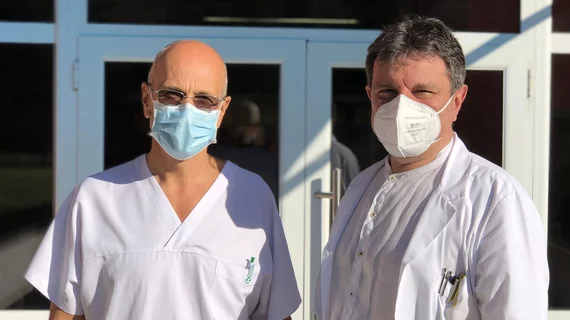At a large tertiary referral hospital in hard-hit Italy, COVID-19 surges suppressed imaging volumes across all modalities except CT. The latter held steady throughout the initial wave in spring 2020 and increased during subsequent peaks.
During one surge, the hospital’s CT volumes spiked to 55% higher than pre-pandemic levels—no doubt due to heavy demand for advanced chest imaging.
How did these fluctuations in imaging procedures affect radiologists’ workloads?
By dropping reads 11% in 2020 as compared with the average of the previous five years—yet re-fattening worklists just barely the next year (1% over the five-year average).
The research was conducted at 1,200-bed Niguarda Hospital in Italy, an affiliate of the University of Milan, and published June 9 in Academic Radiology [1].
Analyzing data on 1.4 million imaging studies, radiologist Francesco Rizzetto and colleagues further found the first wave in 2020 reduced radiologist workloads for all modalities, body regions and types of care setting (relative change from -86% to -10%), except for CT (relative change +3%).
In subsequent waves, workload increased only for CT (mean relative change +18%) and for breast imaging (mean relative change +23%) and cardiovascular imaging (+23%).
For all other categories, the researchers report, overall radiologist workloads only rebounded to near pre-pandemic levels in the fourth COVID wave (October through December 2021).
Outpatient Imaging Absorbed the Shock
Throughout pandemic-affected time windows, decreases in radiologists’ workloads owed primarily to reduced outpatient imaging. Tellingly, the outpatient decreases paralleled increases in inpatient and emergency imaging.
“The relevant decrease in workload observed in 2020, especially in the first wave of the pandemic, is not surprising,” the authors comment in their discussion. “Healthcare systems were unprepared to face the exponential surge in cases of an almost unknown disease and, obviously, highly precautionary measures prevailed, both in and out of the hospital setting.”
Against this backdrop, the up-to-55% spike in CT imaging occasioned by heightened demand for chest studies “can be explained by the excellent sensitivity of CT imaging for early pulmonary changes, which was crucial in a setting with limited capability of COVID-19 testing and long turnaround times, like in the first wave when only PCR (lab) tests were available,” Rizzetto and co-authors write.
More:
Our study showed that an effective organization of hospital resources, ensuring availability of healthcare services, was almost reached only in the last wave, almost 18 months after the pandemic beginning, thanks to the synergetic contribution of high vaccination coverage that drastically reduced the proportion of patients actually needing emergency care and/or hospitalization.”
COVID-19 Made Radiologists More Nimble, Edifying the Entire Institution
The authors add that the present analysis confirms that COVID-19 forced formidable and protracted change on radiologists.
Their experience now offers all clinical departments and medical specialties “a broad view of the temporal evolution and modalities of response to the succession of different pandemic waves, progressively resuming to normal—and in some cases even greater—operating capacity.”
Understanding these dynamics, Rizzetto et al. conclude, “is the key to improving the responsiveness of healthcare institutions and planning the reorganization of imaging services to face extreme contingency situations.”
The journal has posted the study in full for free.
More Coverage of COVID-19 Imaging
Radiologists best AI at diagnosing COVID on chest X-rays
Q&A: Should COVID vaccinated patients delay getting breast imaging — new study says no
Imaging shows COVID vaccines effective at warding off pulmonary embolism
Pandemic’s hardest hit breast-care segment: Screening mammography
Reference:
- Francesco Rizzetto, Angelo Vanzulli, et al., “Impact of COVID-19 pandemic on the workload of diagnostic radiology: a 2-year observational study in a tertiary referral hospital.” Academic Radiology, June 10, 2022. DOI: https://doi.org/10.1016/j.acra.2022.06.002

